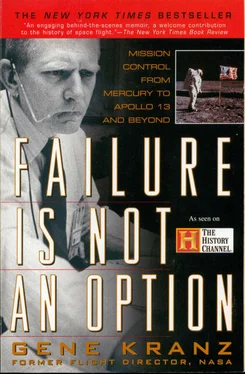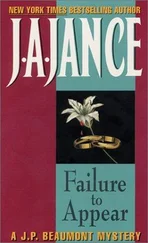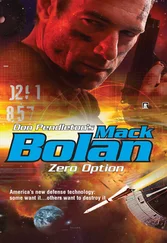I logged the liftoff time (9:34 Eastern Standard Time) as 1434Z (Z for Zulu, or Greenwich mean, time, used to establish a standard time for all the tracking stations scattered throughout different time zones) in the Teletype message, turned in my chair, and took off to the Teletype center. Oops. I had not removed my headset. After I’d run about fifteen feet, the headset cord stretched to the maximum, snagged a chair, and sent it tumbling to the floor. Kraft, distracted, looked in my direction, frowned, then returned to the business of launching the first American into space.
Sheepishly, I picked up the chair and returned to the console as Shepard made his thirty-second status report. Shorty Powers announced to the world that “everything is A-OK,” a phrase hated by the controllers and crews as “too Hollywood,” but one that soon became a part of the American vocabulary. It seems quaint now, all these years later, virtually unused, almost forgotten.
The two previous Redstone missions taught me that a ballistic mission is over in a flash. An energy-charged 142-second rocket launch followed by a five-minute weightless period, retrofire, and then a reentry. The drive from the hotel to Mercury Control was longer than the fifteen-minute flight time. Shepard’s mission was just like my first jet solo, a blur of noise and motion, an event long anticipated that was over far too soon.
Indeed things were A-OK. After over four hours in the capsule, Shepard was in peak form reporting launch events. At liftoff his heart rate had briefly increased to 120, peaking five minutes later at 140 beats per minute as Shepard called, “Booster cutoff.” Now weightless and traveling one mile per second, Al was in the test pilot’s nirvana. I was damn happy that the mission was going well and that Al’s performance would answer the medical scientists’ concerns about whether man could function in space. I had always felt that the flight surgeons were too plodding, too conservative for the rapidly evolving program.
After capsule separation from the booster the automatic system turned the capsule into a heat-shield-forward position. Approaching the 116-mile-high apogee (the highest altitude on the trajectory), Shepard took over manual capsule attitude control, maneuvering in the roll, yaw, and pitch axes and reporting that the capsule responded much as the simulators had. Using the periscope he reported seeing the western coast of Florida and the Gulf of Mexico.
Only moments later, Carl Huss broke into the communications loops, beginning the countdown to retro sequence. His words hung briefly, then were echoed by the MCC CapCom, “5… 4… 3… 2… 1… Retro sequence!” Shepard confirmed he had maneuvered the capsule to attitude for rocket firing.
The weeks of frustration and training were finally paying off in a perfect mission. Now all we needed were the parachutes.
I listened, amazed at the professionalism that had developed in the Mercury team in the six months since I had joined. The pad team, Mercury Control, and the recovery forces were working in perfect synchronization, with an almost casual tone in their voices as if they had done this many times before. In less than fifteen minutes our first manned mission was over.
Shepard was safely aboard the aircraft carrier Lake Champlain eleven minutes after landing. While dictating his pilot’s report on the carrier Shepard was called to the carrier’s flag bridge to answer an unexpected telephone call. President Kennedy had watched the launch and landing closely via television and was now one of the first to congratulate America’s new space hero. Kraft rapidly wrote out his mission summary report. It was less than two pages in length. It was now time to celebrate.
3. “GOD SPEED, JOHN GLENN”
We consumed large quantities of beer and barbecue at Fat Boy’s in honor of Al, and reveled in the day’s headlines: “U.S. SCORES SUCCESS IN FIRST TRY TO PUT MAN IN SPACE.” “ALL AMERICANS ARE REJOICING, SAYS KENNEDY.” Alan Shepard had become America’s hero, but more so he was uniquely our hero.
The Space Task Group had little time to savor the wine and smell the roses before we had to do it all over again. In two months the second astronaut would go up. This gave Kraft’s team an opportunity to apply the lessons we had learned during the turnaround to our next mission. The combination of our technical successes and President Kennedy’s vow to land a man on the Moon in this decade spurred us on. When I read Kennedy’s speech, delivered to a joint session of Congress on May 25, 1961, “A Special Message from the President on Urgent National Needs,” I found it almost impossible to grasp that our nation had established the lunar target as the prize in the space race. I had always yearned to be involved in an undertaking that would challenge the imagination of man. Any doubt I ever had about moving into space vanished.
To those of us who had watched our rockets keel over, spin out of control, or blow up, the idea of putting a man on the Moon seemed almost too breathtakingly ambitious. Word about the speech spread like wildfire through our offices at Langley; all work virtually came to a halt and people began to offer various opinions. Most wondered if this was for real. It seemed, at that moment, like a pipe dream. I thought, “Well, let them get on with their great plans; I’m gonna get a man into orbit first.” But it became real for us in the months that followed, particularly when Kennedy gave a speech sixteen months later at Rice University affirming his commitment to a lunar landing. I saw Kennedy when he came to visit Mercury Control at the Cape with Shepard and Glenn. His energy and charisma were electrifying; he made believers out of all of us, even the most skeptical. Our hopes had been renewed; maybe Kennedy really understood the towering odds we faced—and were willing to overcome.
When Kennedy first announced this ambitious goal we were back at Langley, preparing for the second manned Mercury mission, which would be flown by Gus Grissom, who had been Shepard’s backup. For a change we had a breathing space of almost two months before we deployed to the Cape. Now that we had flown Shepard successfully, the pressure eased for a while. Then, on July 21, 1961, at 7:20 Eastern Standard Time, Grissom made the second suborbital flight on another Redstone, his capsule bearing the name Liberty Bell 7 . His flight was virtually a carbon copy of Alan’s. This launch doubled our manned time in space; we reached one half hour.
Grissom was a likable guy, seasoned, decisive, and taciturn. An Air Force cadet at eighteen, he had flown a hundred combat missions in Korea. When he first arrived in Korea, he found that until they had been shot at by a MiG, pilots were not allowed a seat on the bus to the flight line. Gus stood only once. On his first mission, he went looking for a MiG, found one, shot it out, and qualified for a seat on the bus.
Everything went well during the flight but shortly after Grissom’s splashdown, the hatch inadvertently released. With the hatch open, the capsule started to take on water. In his silver space suit, Gus fought his way to the surface and swam a short distance away. In Mission Control, we sat helpless as a nearby helicopter grappled the loop at the top of the capsule to prevent it from sinking. By the time the helicopter took up the slack in the lift cable, the capsule had partially submerged. With the capsule under water and sinking fast, a tug-of-war began between the helicopter and the sinking spacecraft.
Almost unnoticed, Grissom was struggling as the downwash from the chopper’s rotor blades whipped the sea to a froth. I was sweating bullets, as I recalled the times I stood near the runway, or sat in my aircraft watching and listening as a squadron pilot called “Mayday… Mayday” and attempted to nurse a damaged or flamed-out (no engine power) aircraft back to the runway. The feeling of utter helplessness gets you in the gut. I had seen a student pilot in jet training try to make the runway, finally ejecting too late when he realized he was short. I had that same sick feeling now watching Gus struggling in the water. Water was leaking through the suit inlet hose fitting, and as the seconds passed the space suit buoyancy was no longer supporting him. I kept murmuring aloud at the console, “Dammit, get Gus, forget the damn spacecraft.” As a second helicopter went to Grissom’s rescue, the drama of the capsule recovery seemed to play out forever on our television sets in the control room. The helicopter strained against the load, briefly lifting the capsule almost clear of the water, only to lose the battle as the engine began to overheat. (Through a remarkable feat in deep sea exploration technology, the capsule was located and recovered in extraordinarily good shape in July of 1999.)
Читать дальше












